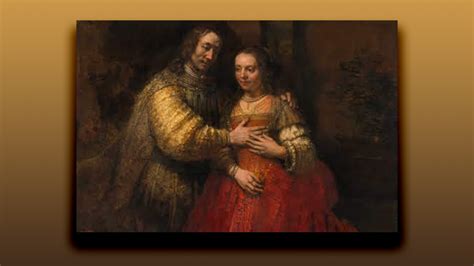Rembrandt van Rijn’s The Jewish Bride is an artwork of profound emotional resonance and technical mastery. Painted circa 1665–1669, it remains a timeless testament to the artist’s ability to convey the deepest human emotions through subtle gestures, textured brushwork, and atmospheric lighting. Housed in Amsterdam’s Rijksmuseum, the painting continues to captivate audiences and inspire countless interpretations, securing its place as one of the most celebrated works in Western art.
The Enigma of the Couple
At first glance, The Jewish Bride captures an intimate moment between a man and a woman. The man’s hand rests gently on the woman’s chest, while his other hand supports her shoulder. This tender gesture, paired with the woman’s serene expression, evokes a sense of affection and protection. Yet, despite the apparent simplicity of the scene, the painting’s subjects remain enigmatic.
The title The Jewish Bride emerged in the 19th century when an Amsterdam art collector interpreted the scene as a Jewish father presenting a necklace to his daughter on her wedding day. This theory, though evocative, has been largely dismissed by modern scholars. Some believe the couple represents biblical figures, such as Isaac and Rebecca, portrayed in a private moment of love and devotion. Others suggest it is a commissioned portrait of a real-life couple, possibly wealthy patrons of Jewish heritage. The ambiguity surrounding the identities of the figures adds to the painting’s mystique, allowing viewers to project their interpretations onto the work.
Artistic Techniques and Innovations
Rembrandt’s brilliance lies in his unparalleled ability to breathe life into his subjects. The Jewish Bride exemplifies his late style, characterized by loose, textured brushstrokes and a mastery of chiaroscuro (the contrast between light and shadow). These techniques create a sense of depth and atmosphere that draws the viewer into the intimate world of the painting.
One of the most striking aspects of the work is the rich interplay of textures. The man’s garments, rendered in earthy tones, contrast with the opulent reds and golds of the woman’s attire. Rembrandt achieves this effect through the impasto technique, applying thick layers of paint to create a tactile quality. The shimmering highlights on the woman’s sleeve and necklace suggest luxury, while the earthy tones ground the scene in warmth and intimacy.
The use of light is equally masterful. The figures are bathed in a soft, golden glow, with their faces and hands emerging from the shadows. This lighting not only emphasizes their emotional connection but also imbues the scene with a timeless, almost sacred quality. It is as if Rembrandt has frozen a fleeting moment of tenderness, preserving it for eternity.
Impression
The emotional power of The Jewish Bride lies in its universality. While the painting may depict specific figures or a historical narrative, its themes of love, devotion, and human connection resonate across cultures and time periods. This is perhaps why Vincent van Gogh, upon seeing the painting, famously declared that he would willingly sacrifice ten years of his life to sit before it with a crust of bread for two weeks. Van Gogh’s admiration speaks to the transformative experience of encountering Rembrandt’s work—a feeling shared by many who stand before The Jewish Bride today.
The painting’s title, though rooted in an outdated interpretation, highlights the significance of Jewish culture in 17th-century Amsterdam. The city was a thriving hub for Jewish merchants and intellectuals, many of whom supported Rembrandt’s work. While there is no concrete evidence linking the subjects of The Jewish Bride to Jewish patrons or traditions, the painting’s title serves as a reminder of Amsterdam’s rich cultural tapestry during Rembrandt’s lifetime.
Contrasting Interpretations
The Rijksmuseum describes the painting as one of the most poignant depictions of love in art history, emphasizing the emotional bond between the two figures. This perspective aligns with modern interpretations that focus on the universality of the human experience. However, earlier interpretations leaned heavily on the biblical and cultural symbolism of the scene. These contrasting views reflect the evolving understanding of Rembrandt’s work, shaped by changing cultural contexts and scholarly research.
The depiction of the man’s protective gesture and the woman’s composed demeanor suggests a relationship rooted in mutual respect and affection. This interpretation has led some scholars to view the painting as an allegory for marital love, with the man symbolizing strength and support and the woman representing grace and beauty. Others, however, argue that the painting’s ambiguity is its greatest strength, allowing viewers to find their own meanings within the intimate exchange.
Technical Mastery Meets Emotional Depth
What sets The Jewish Bride apart from other works of its time is its seamless blend of technical mastery and emotional depth. Rembrandt’s ability to capture the subtleties of human emotion through brushwork and composition elevates the painting beyond a mere portrait or narrative. Each detail, from the shimmer of the woman’s necklace to the shadows that envelop the couple, serves to enhance the painting’s emotional resonance.
The textures in the woman’s dress, achieved through layers of gold and crimson paint, create a sense of opulence that contrasts with the simplicity of the background. This juxtaposition draws the viewer’s attention to the figures, highlighting their emotional connection. Similarly, the man’s earthy tones anchor the composition, creating a balance between the spiritual and the corporeal.
Modern Legacy
The Jewish Bride continues to inspire artists and audiences alike, standing as a testament to Rembrandt’s enduring genius. Its placement in the Rijksmuseum ensures that it remains accessible to a global audience, serving as a focal point of the museum’s collection. The painting’s emotional power transcends cultural and historical boundaries, inviting viewers to reflect on the universal themes of love and connection.
In recent years, The Jewish Bride has also sparked renewed interest in the role of Jewish patrons and culture in Rembrandt’s work. While the painting itself may not have a direct link to Jewish traditions, its title and historical context offer a lens through which to explore the broader cultural influences that shaped Rembrandt’s art.
Rembrandt’s The Jewish Bride is a masterpiece of human emotion and artistic innovation. Its timeless themes of love, devotion, and intimacy resonate as strongly today as they did in the 17th century. Through his masterful use of texture, light, and composition, Rembrandt captures a moment of profound tenderness, inviting viewers into the private world of the couple. Whether interpreted as a biblical allegory, a portrait of real-life patrons, or a universal celebration of human connection, The Jewish Bride remains a work of unparalleled beauty and emotional depth.
The enduring appeal of The Jewish Bride lies in its ability to transcend specific interpretations and speak to the core of the human experience. In a world often defined by chaos and division, Rembrandt’s masterpiece serves as a reminder of the power of love, intimacy, and art to unite and inspire us all.
No comments yet.








